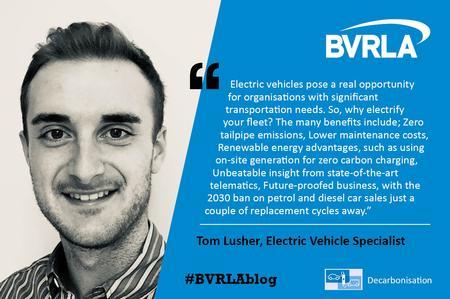In this BVRLA blog, Tom Lusher, Electric Vehicle Specialist at Drax highlights the eight essential steps to electrification and creating business benefits.

Electric vehicles (EVs) pose a real opportunity for organisations with significant transportation needs.
So, why electrify your fleet? The many benefits include:
- Zero tailpipe emissions
- Lower maintenance costs
- Renewable energy advantages, such as using on-site generation for zero carbon charging
- Unbeatable insight from state-of-the-art telematics
- Future-proofed business, with the 2030 ban on petrol and diesel car sales just a couple of replacement cycles away.
Fleet electrification isn’t something that can be achieved overnight - there are many aspects to consider.
I’d like to highlight eight essential steps that will help fleet managers at each stage on the road to electrification, starting with a suitability assessment and ending with how data can be used to optimise the value of your investment.
Step 1 – EV suitability assessment
Before you introduce EVs into your fleet, you’ll want to understand and prove the benefits.
Start with a full review of your current fleet usage to understand your operational requirements. Consider factors like mileage (per trip and per day), load requirements, areas of operation and resting locations as a starter for 10.
Follow with a total cost of ownership (TCO) calculation. Influential factors include cost of ‘refuelling’ with electricity versus diesel or petrol, ongoing maintenance requirements, as well as any tax benefits and toll, levy, or congestion-charge exemptions.
The insight from your fleet review and TCO come together to create your business case.
Step 2 – Vehicle recommendation
Next up, choosing the right electric vehicles for your business.
Much like traditional vehicles, you’ll look at drivability and function versus form. But for EVs, you’ll also look at specifications like range (miles per charge, measured in units of energy, kWh) and charging capability (do you want standard charging speed, or rapid charging capability?)
Some suppliers will arrange EV demonstration days. These let drivers and decision makers try recommended vehicles before committing to purchase.
Step 3 - Charging infrastructure assessment
At this stage, you’ll decide two things: what kind of charge points you want and where they’ll go.
You might think you need charge points at every site you own. But unless your vehicles regularly travel over 100 miles per day, you may be surprised at how few charge points you actually need.
As for type of charge point, this is all down to speed. Slow charge points are cheaper and ideal for overnight charging. Ultra-rapid charge points cost more, but allow for charging at rest stops.
Step 4 – Hardware implementation
Once you’ve chosen your charging locations, the site survey makes sure your installation is practical and efficient.
Groundworks can be inconvenient, so managing them effectively – such as taking advantage of existing electricity infrastructure – can help minimise disruption and expense. This is the last stage before committing to location.
Step 5 – Charge point management
Time to get plugged in! At this stage, you’ll be ordering and installing your charge point hardware.
Getting your charge points in the ground might require specialist contractors, such as charge point programming experts or a site manager to take responsibility of site works and project management.
Consider using the installation day to raise awareness in your business and communicate why you’ve spearheaded the change.
Step 6 – Maintenance and servicing
Charge points are user-friendly but sophisticated pieces of tech.
Their initial set up will let you enable clever functionality, like programming different tariffs for different types of users.
Some EV partners will provide software that gives real time visibility of your charging network usage. Certain products even let you remotely lock and reset your equipment, helping you to manage your fleet more effectively.
Step 7 – Enabling the power of telematics
What happens if your charge points need updates or develop faults?
Even the best products in the world aren’t immune to faults.
Potential charging infrastructure issues to be aware of include outages and failures. But charging technology is smart; manufacturers or specialists can often detect (and correct) faults before the end-user is even aware that anything’s wrong. Be sure to understand what data is being captured so your processes can be developed to suit.
Step 8 – What next?
Once your electric fleet is up and running, you can use data to optimise the value of your investment.
EV-specific telematics data can provide valuable information, like how efficient your drivers are. Even minor tweaks to driving styles can make journeys more power efficient, which adds up to operational savings.
The more you use your EVs, the more data you gather and the more you can maximise your operation.
Drax has created a detailed guide to switching to electric vehicles. Understand how you can evolve your fleet and create real business benefits.





